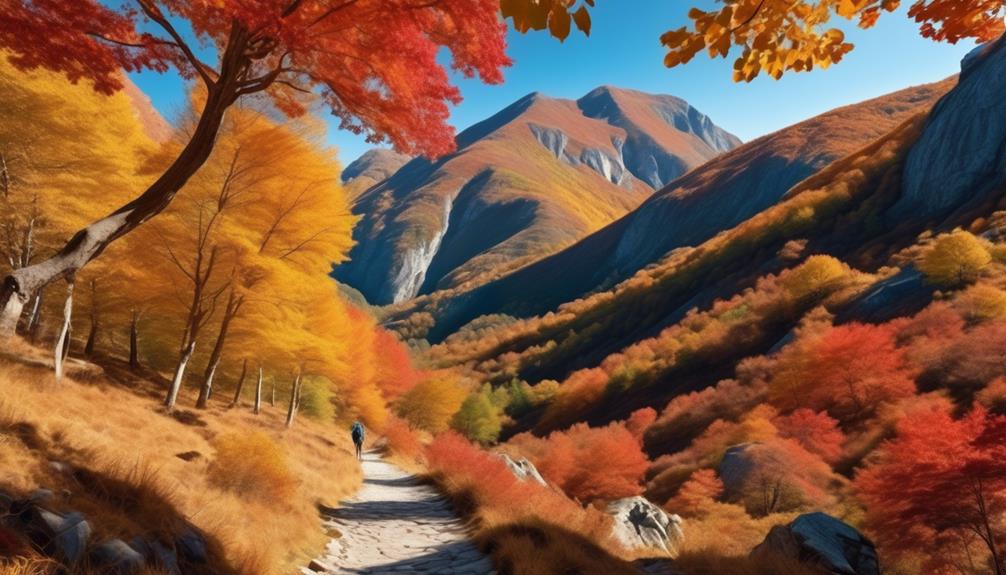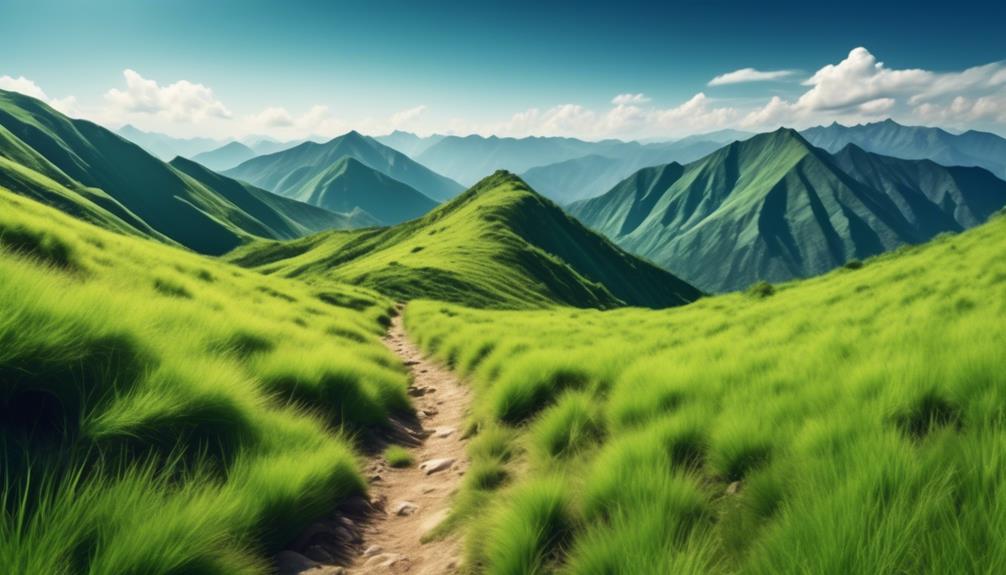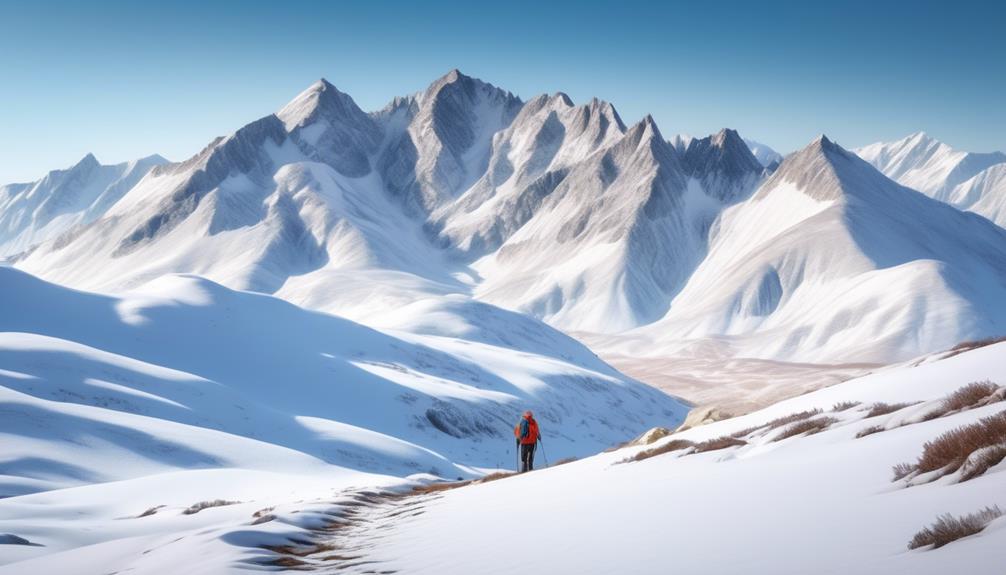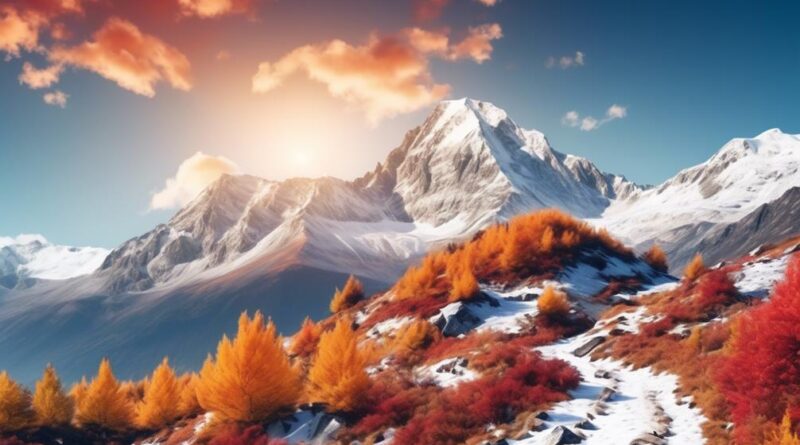What Is the Ideal Season for Mountain Trekking?
When it comes to mountain trekking, finding the ideal season is like navigating a winding trail—there are several factors to consider before setting out.
From the crisp air of spring to the vibrant colors of autumn, each season offers its own unique appeal for adventurous hikers.
So, what is the best time to embark on a mountain trek? Let's explore the different seasons and their respective merits, allowing you to make an informed decision for your next outdoor escapade.
Spring Trekking Season
Spring is the ideal season for mountain trekking, offering moderate temperatures and blooming landscapes. As you hit the trails during spring, it's essential to be aware of the trail conditions. The snowmelt from higher elevations can lead to muddy and slippery paths, so be sure to have appropriate footwear to navigate these conditions. Additionally, some trails may be closed or have restricted access due to lingering snow or ice, so it's crucial to check with local park rangers or trail authorities for the latest updates before embarking on your trek.
One of the most enchanting aspects of spring trekking is the opportunity for wildflower sightings. The mountains come alive with vibrant colors as wildflowers start to bloom, creating picturesque scenes along the trails. Keep an eye out for various species such as lupine, Indian paintbrush, and mountain bluebells. These floral displays add an extra layer of beauty to your trekking experience, making it a feast for the eyes.
Being prepared for changing trail conditions and embracing the chance to witness stunning wildflowers will enhance your spring mountain trekking adventures. So, lace up your hiking boots, pack your essentials, and get ready to immerse yourself in the natural wonders that this season has to offer. Happy trekking!
Summer Trekking Season
As the temperature rises and the landscapes transform, summer brings a new energy to mountain trekking adventures. The summer trekking season offers a unique experience with its longer daylight hours and vibrant natural surroundings. Here's what you need to know to make the most of your summer mountain trekking:
- Trail Conditions
- The summer season often means drier trail conditions compared to spring, making it easier to navigate and traverse the paths. However, be cautious of potential hazards such as loose rocks or slippery gravel in certain areas due to decreased snowmelt and increased foot traffic.
- Gear Essentials
- Lightweight and breathable clothing is essential for summer trekking to combat the heat and humidity. Consider moisture-wicking fabrics and sun-protective clothing to stay comfortable and shielded from the sun's rays. Additionally, ensure you have a reliable water filtration system or adequate hydration packs to stay hydrated throughout your trek.
Summer trekking season provides an excellent opportunity to explore the mountains with its clearer trails and longer days. By being mindful of trail conditions and packing the right gear essentials, you can fully immerse yourself in the beauty of nature while enjoying a safe and enjoyable trek during the summer months.
Autumn Trekking Season

Prepare for a breathtaking adventure as you transition into the autumn trekking season. This is the perfect time to immerse yourself in nature's vibrant canvas of foliage colors. As the temperatures begin to cool down, the landscape transforms into a mesmerizing display of reds, oranges, and yellows, creating a picturesque backdrop for your trekking experience.
One of the most remarkable aspects of autumn trekking is the stunning foliage colors that adorn the mountains. The lush greenery gives way to a rich tapestry of warm hues, painting the surroundings with an unparalleled beauty. Walking through trails lined with trees ablaze in autumnal colors is an experience that will stay etched in your memory forever.
As you traverse through the mountain paths during the autumn season, you'll also notice significant temperature changes. The crisp, refreshing air adds an invigorating element to your trek, making each step all the more exhilarating. The cooler temperatures create a comfortable environment for trekking, allowing you to fully enjoy the journey without being weighed down by the heat of summer.
Winter Trekking Season
Now that you've marveled at the stunning foliage colors of autumn trekking, brace yourself for the exhilarating challenges of winter trekking. Winter trekking offers a whole new level of adventure as you navigate through snow-covered trails and witness breathtaking snowy landscapes. Before embarking on this thrilling journey, it's crucial to be well-prepared and equipped for the unique demands of winter trekking.
When venturing into the winter wonderland for trekking, it's essential to consider the snow conditions. The pristine white snow can create a mesmerizing setting, but it also brings forth its own set of challenges. The depth and texture of the snow can significantly impact the trekking experience, affecting your pace and energy expenditure. Being mindful of the snow conditions allows you to adapt your trekking strategy accordingly, ensuring a safe and enjoyable expedition.
Gear preparation becomes paramount for winter trekking. Your regular trekking gear mightn't suffice in the snowy terrain. Investing in insulated and waterproof boots, along with gaiters to keep the snow out, is crucial. Additionally, thermal layers, waterproof outerwear, and proper headgear are essential to combat the cold and stay dry. Carrying extra supplies such as hand warmers, a sturdy ice axe, and snowshoes can also be beneficial, depending on the trek's difficulty level and the expected snow conditions.
As you gear up and assess the snow conditions, you're ready to embrace the winter trekking season with confidence and excitement. The unique challenges and pristine beauty of winter trekking await your exploration.
Best Weather for Trekking

With the right weather conditions, trekking becomes an exhilarating and enjoyable experience, allowing you to fully immerse yourself in nature's beauty. When it comes to the best weather for trekking, favorable weather conditions can make a significant difference in your overall experience. Ideally, you want to embark on your trek when the weather is mild and stable. This means clear skies, minimal precipitation, and comfortable temperatures.
Weather conditions play a crucial role in ensuring a safe and pleasant trekking experience. The ideal temperatures for trekking typically range between 50°F to 70°F (10°C to 21°C). These temperatures provide a comfortable environment for exerting physical energy without feeling too hot or too cold. Additionally, stable weather conditions with minimal wind and precipitation are preferred to avoid potential hazards and discomfort.
Trekking during favorable weather conditions not only enhances your overall experience but also ensures safety. It allows you to fully appreciate the stunning landscapes, diverse flora, and fauna without the hindrance of extreme weather. Moreover, pleasant weather conditions make it easier to stay hydrated and maintain energy levels throughout your trek.
Always ensure to check the weather forecast before embarking on your adventure, as being prepared for the best weather conditions will significantly contribute to an unforgettable trekking experience.
Peak Season for Mountain Trekking
The peak season for mountain trekking typically coincides with the drier months and milder temperatures, attracting enthusiasts seeking optimal hiking conditions. During this time, the advantages of peak season trekking include clear skies, allowing for breathtaking panoramic views, and the opportunity to witness diverse flora and fauna in full bloom.
However, the disadvantages may include larger crowds and higher prices for accommodations and tours. As you plan your trek, keep in mind that some popular destinations during peak season include the majestic peaks of the Himalayas, where you can experience the cultural richness of Nepal and Bhutan while trekking to Everest Base Camp or the Annapurna Circuit.
Additionally, the Swiss Alps beckon adventurers with their well-maintained trails and stunning vistas, making destinations like the Matterhorn and Eiger particularly popular during peak season. Overall, while peak season offers ideal weather conditions and unparalleled natural beauty, it's important to consider the potential drawbacks such as increased tourist traffic and elevated costs.
Regardless of the destination you choose, peak season for mountain trekking promises an unforgettable experience amidst nature's grandeur.
Off-Season Trekking Opportunities

As you consider your trekking options, exploring off-peak seasons can provide quieter trails and a chance to experience the mountains in a more serene and intimate setting than during the bustling peak season. Off-season trekking also opens up opportunities to explore remote destinations that may be inaccessible or overcrowded during the peak season.
In remote destinations, off-season trekking offers a unique experience with fewer fellow trekkers, allowing you to immerse yourself in the natural beauty and tranquility of the mountains. The trails are less crowded, enabling you to enjoy a more personal connection with the surroundings. Additionally, the weather conditions during the off-peak season can add an element of adventure to your trek. While the weather may be more unpredictable, it can also provide a different perspective of the landscape, with snow-capped peaks or lush greenery, depending on the time of year.
Moreover, off-peak trekking seasons often offer lower prices for accommodations and tours, making it a more cost-effective option. However, it's essential to be well-prepared for the potential challenges that come with off-season trekking, such as fluctuating weather conditions and limited facilities. Nevertheless, for those seeking a more solitary and rugged experience, off-season trekking provides a chance to explore the mountains in a truly unique and captivating way.
Factors to Consider for Trekking Timing
Considering the timing of your trek is crucial for a successful and enjoyable mountain adventure. When planning your mountain trek, it's essential to take into account the weather conditions and trail difficulty to ensure a safe and pleasant experience.
- Weather Conditions
- Season: The time of year you choose for your trek significantly impacts the weather conditions you'll encounter. For example, trekking during the summer months may bring warm temperatures but also the possibility of afternoon thunderstorms. On the other hand, trekking in the winter could mean dealing with snow and icy conditions.
- Local Climate: Research the specific climate patterns of the mountain region you plan to trek in. Some areas may have a monsoon season or a dry season, which can affect the trail conditions and overall trekking experience.
- Trail Difficulty
- Terrain: Consider the type of terrain you'll encounter on the trail. Some trails may be steep and rugged, while others could be more gradual and well-maintained. Understanding the terrain will help you prepare physically and mentally for the trek.
- Elevation: Trails at higher elevations may pose additional challenges due to thinner air and harsher weather conditions. It's important to assess your fitness level and experience before tackling high-elevation treks to ensure your safety and enjoyment.
Frequently Asked Questions
What Are the Best Types of Gear and Clothing to Bring for Mountain Trekking in Different Seasons?
When mountain trekking in different seasons, it's essential to have the right gear and clothing. Consider types of waterproofing and layering techniques for variable weather. Choose the right footwear and pack backpack essentials for a comfortable and safe journey.
Are There Any Specific Health or Safety Concerns to Be Aware of When Trekking in Each Season?
Be aware of specific health and safety concerns when trekking in each season. Seasonal weather and trekking altitude can impact your trek. Prepare for temperature changes, altitude sickness, and potential weather hazards to ensure a safe and enjoyable trekking experience.
How Do the Different Seasons Affect the Availability of Accommodations and Facilities for Mountain Trekkers?
During mountain trekking, the different seasons impact the availability of accommodations and facilities. It affects the local economy as businesses gear up for peak seasons. Weather conditions and terrain also play a role in determining what services are accessible.
Are There Any Seasonal Wildlife or Natural Phenomena That Trekkers Should Be Aware of or Try to See During Their Trek?
When trekking in the mountains, keep an eye out for seasonal wildlife and natural phenomena. Depending on the season, you may witness environmental impacts and photography opportunities like migrating animals or blooming flowers.
What Are Some Lesser-Known or Off-The-Beaten-Path Trekking Routes That Are Particularly Enjoyable During Certain Seasons?
For hidden trails and scenic views, consider trekking the lesser-known routes during specific seasons. You'll encounter weather challenges but also unique experiences, like vibrant fall foliage or blooming wildflowers in spring.
Conclusion
So, whether you prefer the blooming flowers of spring, the warm sunshine of summer, the colorful foliage of autumn, or the serene snow of winter, there's an ideal season for mountain trekking for everyone.
Consider the weather, peak season crowds, and off-season opportunities to make the most of your trekking experience.
No matter when you go, the mountains are waiting for you to explore and enjoy their beauty.
Happy trekking!
